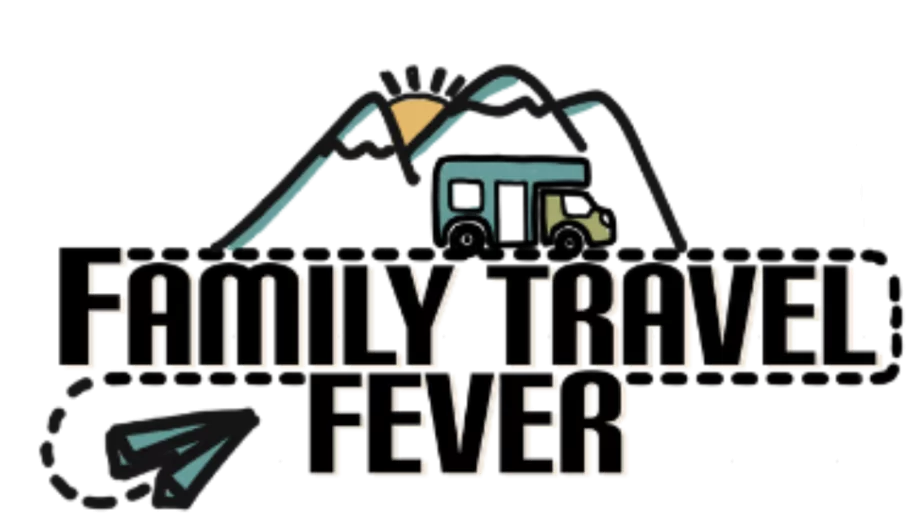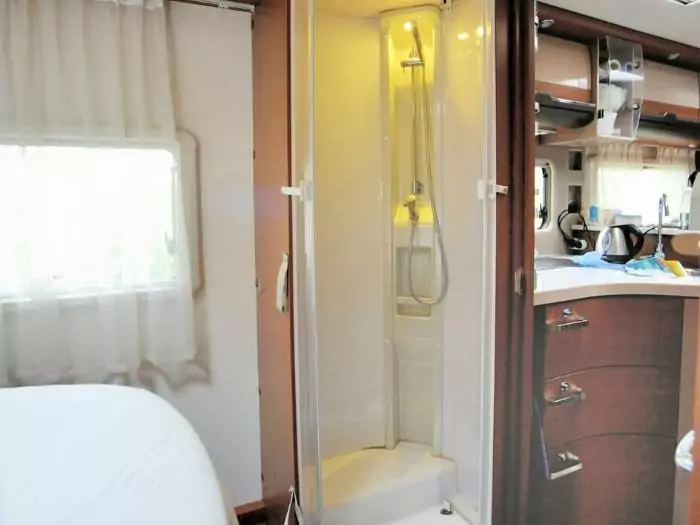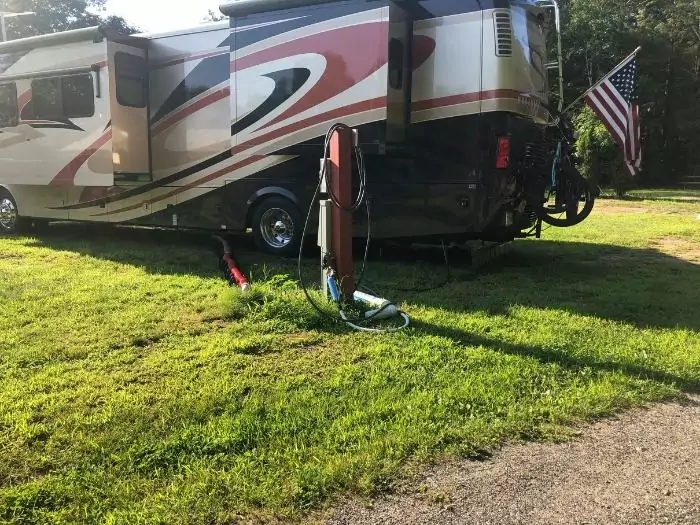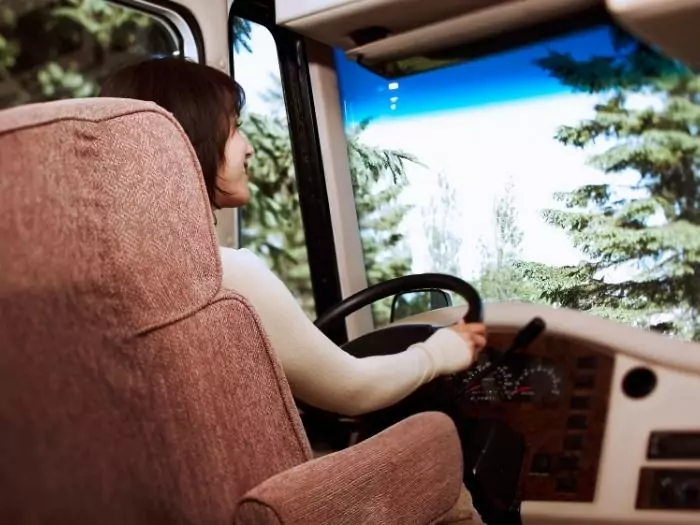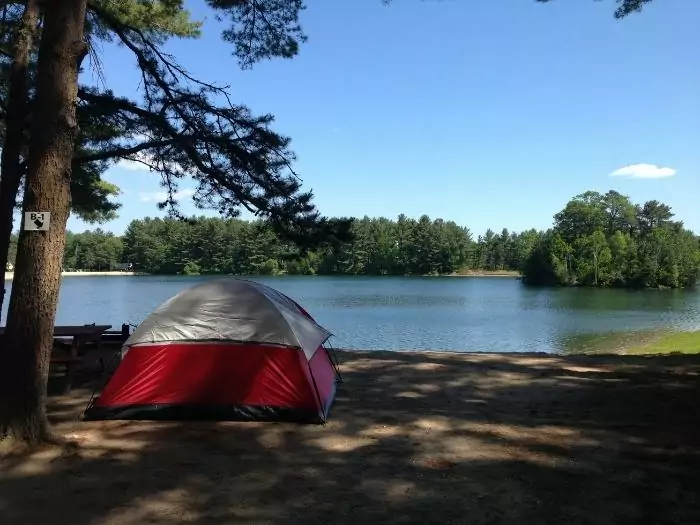RV Shower Won’t Drain: 7 Common Causes And Fixes
NOTE*** The content on this page may contain affiliate links, we may make a commission. And, as an Amazon Associate, we earn from qualifying purchases. More information: disclosure page.
Realizing that your RV shower won’t drain can be frustrating. This is especially true if it’s the first time to ever happen to you and you’re left totally clueless as to where to start. Even as a seasoned RVer, this actually happened to me twice this summer! Once, I made an embarrassing mistake that I will tell you about.
Just so you know, we are generally talking about the RV shower or bathtub not draining. I have a combination shower/tub so the greywater backs up into the tub in my trailer. From my experience, I can answer: why is my camper shower not draining?
If your RV shower is not draining, you may simply have a full gray water tank (maybe from forgetting to open the valve at full hookups), there may be a clog in the shower drain or P-trap, or the plumbing vents may be blocked.
Actually, I can think of 7 reasons why your shower is not draining. We will discuss these 7 common problems and show you the easiest fix.
Why is my RV shower not draining?
- The grey water tank is full.
- The grey water drain line valve is closed.
- RV’s air admittance valve isn’t working properly.
- The drain from the shower or tub could be clogged.
- Plumbing vents could be blocked.
- The P-trap below the shower can get clogged.
- Your shower drains into the black water tank.
With the proper knowledge and right materials on hand, you can pinpoint the exact cause and know what to do about it next. With that, I have listed some of the common reasons as to why your RV shower is not draining. I’ve also included their fixes as well as some important tips to keep in mind.
There are a few different possibilities as to why your RV shower won’t drain. The most common one is actually the most obvious as well, which is that your tank is simply full. If this is not the case, though, you can go on and look for any visual traces as to why your shower is not draining. Some of these include clogged drains or blocked vents.
If you’re still not sure what caused the problem, check the list below for further details and see what seems to best explain your situation.
The Grey Water Tank is Full.

The shower or tub drain is generally the lowest drain point in your RV. So if the gray water tank is full, the first place you will see the water is the bottom of the shower.
When the RV’s grey water tank gets filled to the brim, the water it has accumulated can start overflowing into the shower or sink where it is connected. This is why your RV shower is draining slowly or won’t drain at all.
Sometimes, you may even see the water coming up on the lowest drain of your RV’s greywater system.
Generally, you can look at the indicator lights to know if your grey water tank is actually full.
However, the readings on the tank level gauges can sometimes be inaccurate, or the holding tank monitor can be broken.
Honestly, I had this problem when we were not hooked up to full hookups during our summer on the east coast. And the worst part was it took me a while to figure it out:)
Solution:
The easiest solution is to keep your RV hooked up and make sure your indicator lights are working.
A good rule of thumb is to always check the gauge first. If you see in the indicator that your tank’s 3/4 full, go to the nearest dump station and empty it.
Here is our guide on where to empty waste tanks.
If the monitor shows that it still has space, try draining the grey water tank regardless to eliminate this as a possible cause. See if this resolves the problem. After that, you can search for ways to fix your tank gauge or look for a professional to troubleshoot it.
Pro tip: Make it a habit to frequently check your water tank levels. Do this daily and try not to wait until the tanks become too full. It’s best to dump them as soon as they reach the 3/4 full mark.
The Grey Water Drain Line is Closed.
Embarrassingly, this actually happened to me!
I had successfully hooked up the sewer hose to the tank and fastened them tightly. The thing is, I forgot to open the valve for the greywater to drain into the sewer. And so, the water didn’t flow at all and was still left stuck in the tank.
To make the story short, I was confused as to why the grey water tank still seemed full and wasn’t draining properly. It took me some time to realize why I wasn’t able to successfully drain it!
Solution:
Always ensure that the grey water tank valve is securely connected to the sewer hose before anything else. Once fastened properly, the valve must then be pulled to open.
I generally leave the gray tank valves open when hooked up and stationary for a while in a warm place.
To know when the tank’s empty, you can listen closely to see if you still hear liquid coming through. Once it has gone silent, your tank should be successfully drained. Make sure to completely close the valve after draining to avoid any leaks.
Pro tip: You may have heard of some RV owner leaving the grey tank valve open for it to drain continuously in the sewer. While this may sound like a good hack, you may want to reconsider if you have any of these problems:
- A sewer smell from the system coming into to your RV.
- Allowing the tank be at least ⅔ full before emptying is known to create a vortex that can help remove heavier waste solids or scums.
- Try arranging your sewer hose so that it has a little lower spot acting as a p-trap.
The RV’s Air Admittance Valve Isn’t Working Properly.
Your RV’s air admittance valve is used to ensure that your drainage system is vented well. It’s usually located under the sink between the P-trap and the drain line. It allows proper flow of the water to the waste pipe by allowing enough air to get into the system and balancing the pressure inside.
Not to mention that it prevents those smelly sewer gases from escaping into your RV through the sinks, shower, bathroom basins, tubs, and even washing machines.
Read more on the blog about why your RV smells like sewer
However, the air admittance valve can cause drainage problems if it gets damaged or clogged. The valve won’t be able to properly open up and let in enough air for the water to flow.
This is similar to the effect of turning a full bottle of water upside down. If you poke a hole in the bottom or turn the bottle slightly to allow air, the water will flow faster and more smoothly.
Solution:
Check your air admittance valve (AAV) and make sure that it’s properly attached to your drain line. It should be installed vertically and must not be blocked by any items.
If it seems to be properly installed, it could be that the valve itself has failed and needs to be replaced immediately.
Pro tip: AAVs are great for odor control in your RV, but sometimes they can fail and inhibit the fluid draining in the pipe. Its mechanism is similar to the vacuum your finger can create when used to cover the end of a water-filled straw. For an immediate and quick fix, you can try removing it. Proceed to drain your grey water tank into the sewer and see if it works.
The Drain from the Shower or Tub Could be Clogged.

Another common reason for backed-up water is, of course, a blockage. If you’ve made sure that your drain valve is working properly and the tank’s not full yet, you may be encountering a clogged line leading from your shower or tub to the grey water tank. This is usually due to food, hair, or grease buildup – similar to your shower drain at home.
Solution:
- The simplest method and perhaps the first thing you should try is to flush it with dish soap and hot water. If the buildup isn’t too serious, this should do the trick to clearing out the grease and small trash.
- You can also use sink plungers and drain snakes or augers for a more hands-on approach. Note, though, that mechanical augers can damage your plumbing so it’s best to stick to the hand-operated ones.
- There are drain chemicals that are specifically used for RVs – this is the most recommended for you. The drain chemicals can help dissolve the hair and grease build-up.
- You can also use Dawn dishwashing liquid and Dawn with a water softener such as Calgon to break up the grease and gunk. Bleach and other harsh chemicals can cause damage to your plumbing, tank, and seals. So, steer clear away from those.
- If all these options are exhausted, it may be time to call a professional and have them take care of your clogged plumbing problem.
Pro tip: The hose used to attach the valve to the sewer could also be clogged. You can check this by either looking or simply listening to the flow when trying to drain the water. If this seems to be the problem, you can just easily clean the hose with a special rinse wand before flushing it out.
Plumbing Roof Vents Could be Blocked.
Another thing you need to check is your RV’s plumbing vent. This vent is mainly used to regulate air pressure in your drains while removing the unwanted gas and odor away from your RV. It extends to the RV’s roof.
Debris and even animals nests can get into the vent and cause problems.
Similar to AAVs, damage in this vent can disrupt the water and airflow of your plumbing, causing the water to not drain properly.
Solution:
Climb to the roof and clear any debris that could have blocked the vent opening. After that, get a garden hose and run some water into the main opening of the vent.
If this doesn’t clear the problem, you may need to clean the vent pipe and clear out further blockage that is out of reach. You can also use a plumber’s snake or auger to go deeper down the vent pipe if needed. After that, you can continue running some more water and see if it is now pushed down the drain.
If you do not feel comfortable working on the roof and with the vent pipe, you can take your RV into the repair shop.
Pro tip: Problems in plumbing vents usually affect all the drains including those that are connected to the black water tank. This means aside from sluggish shower drains, there will be other signs like strange gurgling toilet sounds. You may also notice a strong sewage smell as a blocked plumbing vent won’t be able to properly handle the airflow.
P-trap Below the Shower is Clogged

Not many RV owners, especially those who are new to the community, know about the shower P-traps. This is the u-shaped pipe that can be easily spotted under the sink. The P-trap holds a small amount of water in it to seal the sewer gas from making its way up the pipe.
A shower P-trap is similar to that of the sink.
It could be one solid piece or an extension pipe attached to the J-bend pipe right beneath the drain hole of the shower. It is used to ensure that the water drains effectively and that the smells and fumes are kept down below. However, as with the sink P-traps, it can get clogged.
We have had problems with the P-trap in the shower before. The water would sit right at the top of the drain and not fully drain.
Solution:
Checking on the P-trap is usually the last resort. That is if all the possible reasons are exhausted and yet the shower still won’t drain.
- To remove the clog, you can try cleaning the pipes with a plumber’s snake.
- Try pouring a mixture of warm water, Dawn dish detergent and vinegar in. And then, try using a bristle brush to reach the area.
- If this still doesn’t work, you can try using an RV drain cleaner.
- Should your RV have an access door, you can try tightening the fittings on the drain trap or just remove the pipe and clean it before putting it back.
- If you’ve done all these and it’s still clogged, it’s best to ask for professional help instead of going through all the trouble of gaining access to it.
Pro tip: This may be a no-brainer but it’s best to avoid buildup in the trap by regularly cleaning it. Not only can this prevent your drain from clogging, but it also serves as a filter to the nasty smell down below.
Your Shower Drains into the Black Water Tank.
This is highly unlikely but if – by some chance – this is the case for your RV, it’s important to know about this as soon as possible. This would mean your black tank is full and blackwater is backing up in your tub. That’s just plain gross.
Sometimes, another camper fixture is designed to drain into the black water tank. This can be especially confusing and honestly not recommended by many. Black and gray water tanks are separated for a lot of reasons, most especially, to maintain sanitation.
However, there are 2 instances when this has happened to me. Older RVs, like the vintage travel trailer I owned, may have only one tank. The current Jayco bunkhouse I own is newer but the outdoor sink drains to the blackwater tank.
Solution:
You can easily assess whether or not your RV has this unfortunate feature. First, drain your gray water tank while leaving the blackwater valve closed. Then switch and open the black water drain valve. Just make sure to completely empty both holding tanks and see if this does the trick.
Pro tip: Even when you’ve got your shower drain problem solved, you might want to be extra sure if this is due to your plumbing system leading your shower drain to the black water tank.
This gives you a better understanding as to how to handle your water drainage in the future, as well as know if there are other fixtures attached to the black water tank. To do this, leave the drain valve at the sewer connection open on either tank before running in some water through the shower drain. See which tank the water would flow through and repeat on other drains, like the kitchen sink.
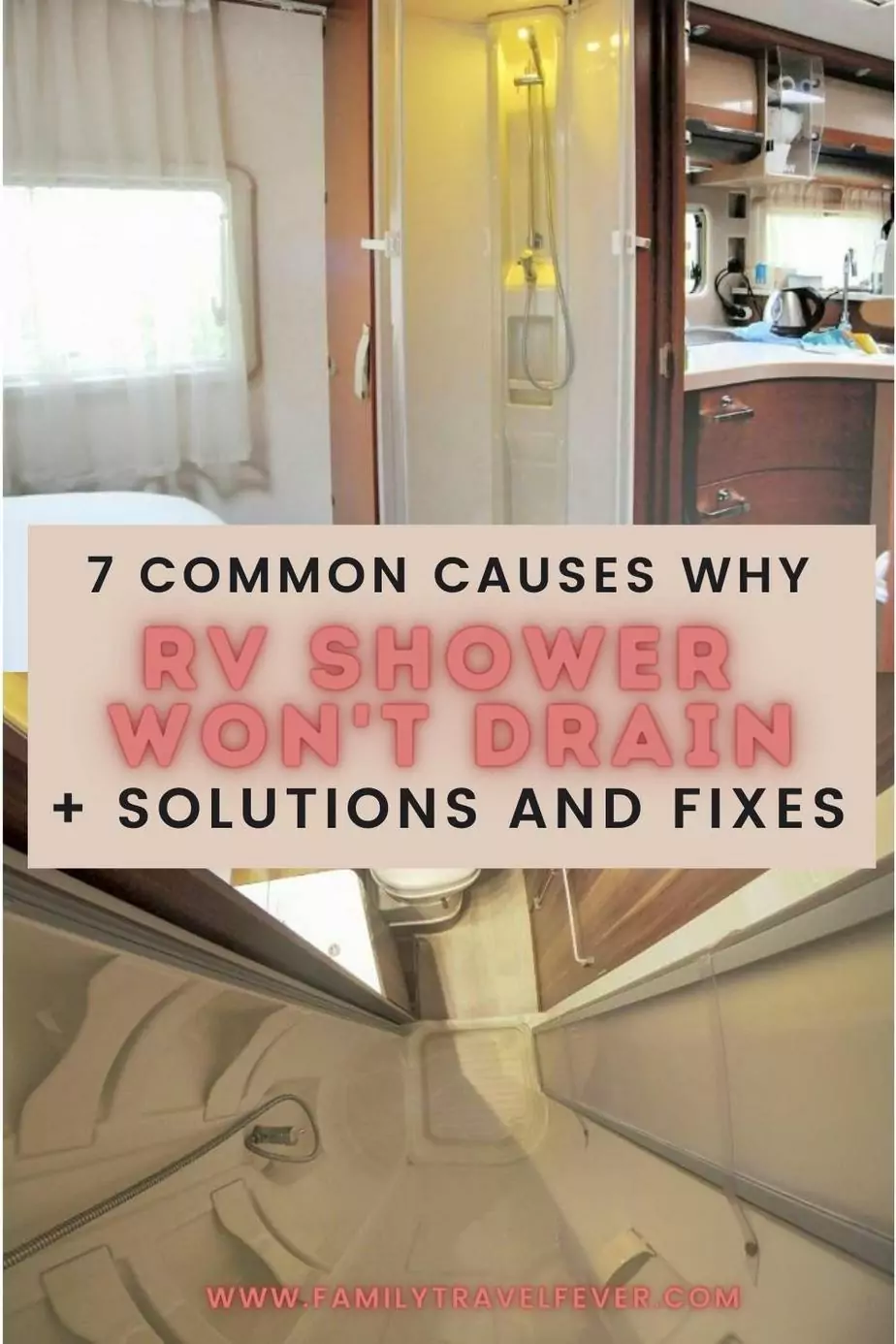
Final Thoughts about How to Unclog RV Shower
As you have read above, the most common problems why your RV shower won’t drain are usually the most obvious ones, like full tanks or clogged drains. In keeping your RV operating smoothly, it is always better to follow the adage “prevention is better than cure”. Most of the problems here can be prevented if you take care of your RV properly. Having said that, it’s important to take every precautionary measure to keep your RV running smooth.
- Does Your RV Have A Sewer Smell Outside? Here’s Why
- Can I Pee In The RV Shower? (Gray Water Tank Questions)
- 11 Smart Pop-up Camper Gray Water Tank Ideas
If you feel overwhelmed about the thought of buying your own RV and having to think of all the things that are needed, I always suggest starting by renting an RV first. You can start by checking out the RV rates on Outdoorsy, RVezy, and RVShare.

Hi, I’m Shauna – Welcome to Family Travel Fever. We are a large family, that was bitten by the travel bug! I take the kids by myself because I don’t mind flying or driving solo with my crew to discover the coolest places.
Sign up for our email list for my best travel tips plus get the family travel planner free.
